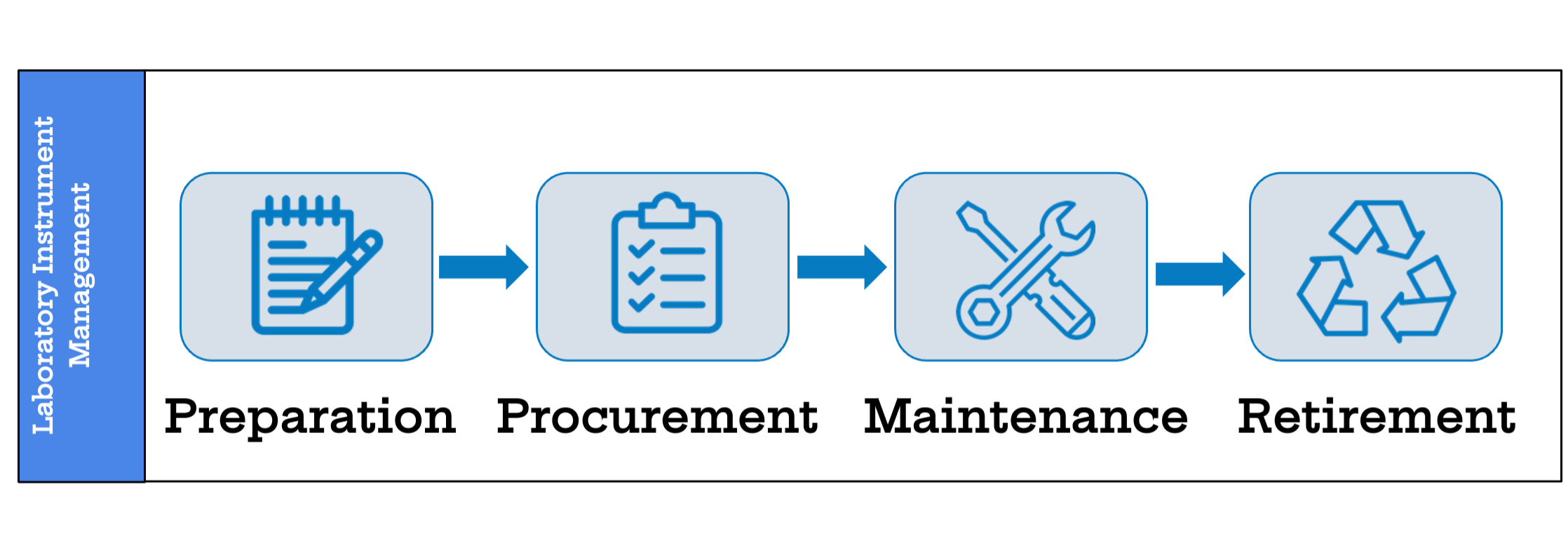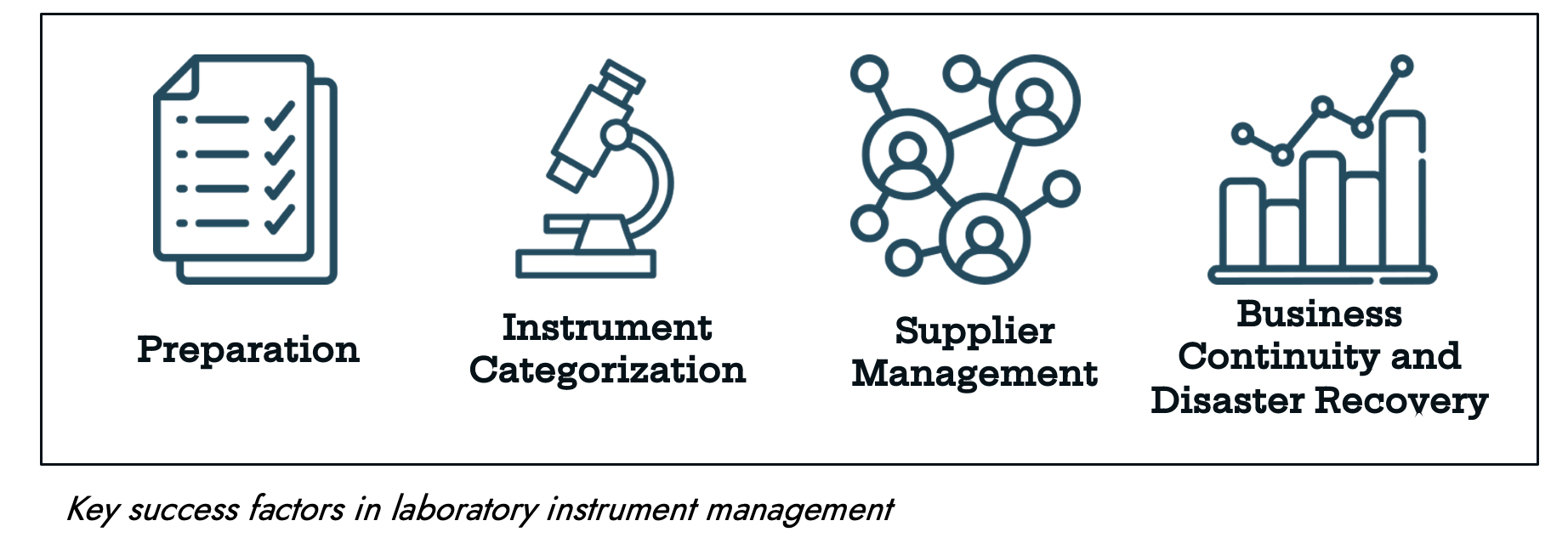Introduction
In today’s fast-paced world, laboratories are expected to produce research at a rapid rate. All too often, organizations attempt to face this challenge by simply purchasing faster, newer instruments and overlook the keys to successfully getting the most out of their investments – automation and instrument management. To maximize the efficiency and utilization of equipment and instruments while minimizing risk and waste, it is crucial that automated laboratories efficiently manage their laboratory equipment lifecycle through every phase – from instrument procurement to maintenance and eventually retirement.

A properly planned and executed Laboratory Instrument Management (LIM) program allows laboratories to minimize repair costs, maximize instrument lifespans, avoid interruptions to their services, and provide full satisfaction to everyone involved, including scientists, operators and customers. Nevertheless, it is a significant challenge to ensure that your LIM program is working at its full potential. In this blog, we will provide tips for success in four key areas that should be a part of every laboratory’s LIM program.

A properly planned and executed Laboratory Instrument Management (LIM) program allows laboratories to minimize repair costs, maximize instrument lifespans, avoid interruptions to their services, and provide full satisfaction to everyone involved, including scientists, operators and customers. Nevertheless, it is a significant challenge to ensure that your LIM program is working at its full potential. In this blog, we will provide tips for success in four key areas that should be a part of every laboratory’s LIM program.
Preparation
Before implementing a LIM program, it is crucial to establish a clear plan that outlines the resources and necessary business processes. This step is often overlooked, ultimately leading to the loss of time and money, as well as delays in the utilization of costly instruments.
The first step in the Preparation Phase involves identifying the internal team that will be involved in the LIM process and document the roles and responsibilities of each team member. It is also necessary to define the roles of suppliers and vendors, as they are often a crucial component in providing instrument maintenance and performing software qualifications. Given the large amount of people involved throughout the process, failure to outline exactly who is responsible for each component will inevitably lead to confusion and could potentially cause the LIM implementation to fail.
In addition, all business processes that are part of the LIM plan must adhere to applicable regulatory requirements and policies. These requirements and policies can impact the necessary instrument and software qualifications, the computer systems that will be required, the training that personnel must receive and other minimum quality requirements for laboratory testing. As a result, laboratories must make certain that proper procedures are in place to meet these requirements and policies before beginning instrument procurement.
Instrument Categorization
Throughout the procurement phase, it is important for laboratories to develop a thorough categorization scheme for their instruments. This facilitates standardization of the onboarding process and prevents confusion. One recommended approach for instrument categorization divides instruments into the following three categories: Program Critical Equipment, Program Non-Critical Equipment, and Non-Critical Equipment. Program Critical Equipment is utilized to make measurements that are then reported directly to the customer. Program Non-Critical Equipment, on the other hand, is not used to make measurements but simply to ensure that measurements are of high quality. In contrast, Non-Critical Equipment is neither used to make measurements to report to the customer nor to assure the high quality of those measurements.
While this categorization scheme will work for many laboratories, there is no perfect categorization scheme for all laboratories due to the vast range of unique activities taking place in each lab. As a result, each organization must create a categorization scheme that meets its specific requirements and goals. For instance, laboratories involved in physical testing or calibrations may benefit from a different categorization scheme than those that work with significant amounts of equipment with associated software.
Supplier Management
Supplier management is another part of the procurement process that is an important factor in the success of a LIM program. There are many issues driving the need for effective supplier management in laboratories. A few of these include: an increasing need for local and global suppliers due to growing operational and geographical scale, a growing need for properly managed suppliers resulting from increasing risks in the supply chain, and greater competition that compels organizations to improve many of their business processes.
In order to ensure that they are receiving the most affordable and highest quality products and services possible, laboratories should work to improve their supplier management in various ways. For instance, establishing processes to negotiate and manage supplier contracts helps laboratories get optimal prices and ensures that both parties are following through with and being held accountable for their contractual agreements. Continuously monitoring supplier performance is another important activity, as it assures the timely identification of problems so that they can be properly addressed before they become major issues.
Open communication with suppliers is another vital aspect of supplier management. This not only ensures that both parties are always in accordance and ready to efficiently work together should problems arise, but it also gives laboratories the opportunity to make certain that their expectations for quality, cost, and other factors are clearly laid out for suppliers. In addition, open communication facilitates the growth of a positive and long-term relationship with suppliers, which can ultimately help laboratories receive the finest products and services available.
Business Continuity and Disaster Recovery
Throughout the maintenance phase of a LIM program, it is crucial that laboratories are adequately prepared for unplanned, adverse events (e.g., natural disasters, cybersecurity incidents, etc.) that may make it impossible for the organization to remain operational. Business continuity and disaster recovery (BCDR) practices allow businesses to carry on their business processes with minimal delays and continue to provide reliable services to customers.
A good Business Continuity Plan (BCP) is crucial to allow businesses to resume operation quickly. In order to put together a good BCP, organizations must have a thorough understanding of the individual needs of each employee during unexpected events. Disaster Recovery Plans (DRP) include both the necessary procedures and the corresponding documentation that facilitates the restoration of an organization’s central IT services. Business Continuity Plans and Disaster Recovery Plans go hand in hand, as the success of the overarching BCP often depends on the success of the DRP.
Conclusion
In order to both survive and thrive in today’s competitive business environment, scientific laboratories must find ways to get the most out of their equipment and instruments. A properly put together Laboratory Information Management program is central to the success of automated laboratories today, as it allows for enhanced productivity, lower regulatory risk and greater profit, among other benefits.
There is no perfect LIM program that will be beneficial to all organizations, as each laboratory’s individual needs depend on countless factors. Each organization must design and implement its LIM program according to the scale of its operations and the regulations that it must abide by. This blog has provided an overview of a few of the key components to consider when creating an individualized LIM program for your laboratory.



